Concrete is a great pond-building material as well as bricks. But both type of pond needs to be waterproofed before you stock it with fish. It can be done by using liner, paint, or other sealants.
In this article, I will talk about the two best pond sealers and paint that you can use to waterproof your Koi pond.
Table of Contents
Our Recommended Pond Sealer And Paint
| Paint | Paint Type | See Details |
| Pond Armor SKU-BLACK-QT-R Non-Toxic Pond Shield Epoxy Paint | Epoxy Paint | Check Price |
| Liquid Rubber Waterproof Sealant | Rubber Sealant | Check Price |
Best Pond Paint: Pond Armor SKU-BLACK-QT-R Non-Toxic Pond Shield Epoxy Paint
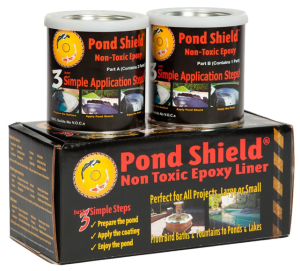
The Pond Armor SKU-BLACK-QT-R is the best epoxy pond paint widely used for sealing concrete ponds. It works on various types of surfaces like brick, stone, and concrete.
The best thing about this pond paint is it doesn’t require any primer like rubber paint and it only requires 24 hours to cure. It gives a very smooth surface. Therefore, there will be less algae growth in it and cleaning is very easy.
Also, Pond Shield made this Epoxy paint flexible, not brittle. Hence, it will not crack with the concrete and hold water well.
It is safe for fish, plants, and other animals. You can also use it for a turtle pond and birdbath. It also has great temperature resistance. It can prevent the freeze and thaw action due to temperature change and hence lasts longer.
The coverage of this epoxy paint is awesome. The pack of 1.5 quarts will cover 60 square feet in one coat. It is available in 8 different colors.
Best Pond Sealer: Liquid Rubber Waterproof Sealant
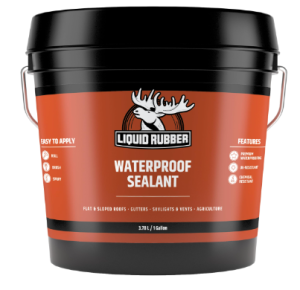
Liquid Rubber Waterproof Sealant is the best concrete pond sealer. It is a water-based liquid rubber sealant that is safe for both fish and the environment. It is free from any solvent and also VOC-free. It works on various types of surfaces and concrete.
After application, it will form a membrane that is fully waterproof and gives a pleasing appearance. In the bottom, you should apply 3-4 coats at the bottom and 2-3 coats at the side.
The coverage of this sealant is good. It gives 50 square feet per gallon for the flat surface and 100 square feet per gallon for the vertical surface. Use a paintbrush or roller to apply this sealant. Use 2 coats of primer before you apply this one.
This liquid rubber sealant should be applied in a completely dry condition. The surface should be free from dust, grease, oil, and paint. While using the surface temperature shouldn’t be less than 5 degrees Celcius.
It will take one to two days to cure. And after that, it will fully hold the water in your pond.
What Type of Paint or Sealer is Used for Waterproofing Pond
Although there are many ways to seal a pond, Epoxy paint, and Liquid Rubber paint are the most widely used. You can also use other water-based waterproofing paint for this purpose. But these two work best.
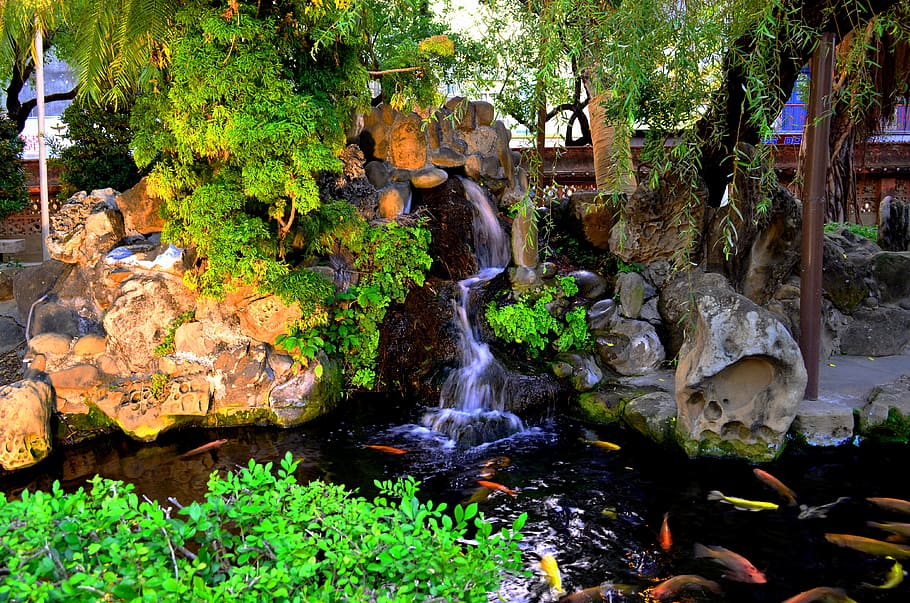
Epoxy paint
Epoxy paint is the first choice of pond owners and there are good reasons behind that. It consists of a base as a curing agent. After you have finished painting your concrete pond, it will give you a durable waterproof surface.
The reason is Epoxy is resistant to chemical agents which makes it last longer. Another good side of Epoxy Paint is it is entirely safe for fish, pond plants, and any other animal.
Epoxy paint is brittle. Hence if the concrete has a micro-crack and any settlement occurs after the painting is done, it will break in that place.
The downside of epoxy is it is more expensive than other paints. But being nontoxic it is still the first choice when it comes to painting a concrete pond.
Rubber paint
As a substitute for Epoxy Paint, you can use Liquid Rubber paint. It is cheaper than Epoxy and can give almost the same performance.
After application when it is cured, it forms a waterproof membrane. Being flexible it will not damage easily. Also, rubber paint doesn’t contain any volatile material and is non-toxic to fish and other animals. You can use this one when you want to save some bucks.
Why You Should Seal Or Paint Your Concrete Pond
The first reason why we paint or seal our concrete pond is to stop lime leaching. Concrete contains a large amount of lime. Not all the lime is used when the concrete sets because it is a never-ending process. The hydration and setting of concrete go forever. If you add water to a newly constructed concrete pond, you will see thing layer of lime over it after 24 hours.
Now, this extra amount of lime can leach and mix with pond water. Lime in water is harmful to fish. So to stop lime leaching, we should seal the concrete pond.
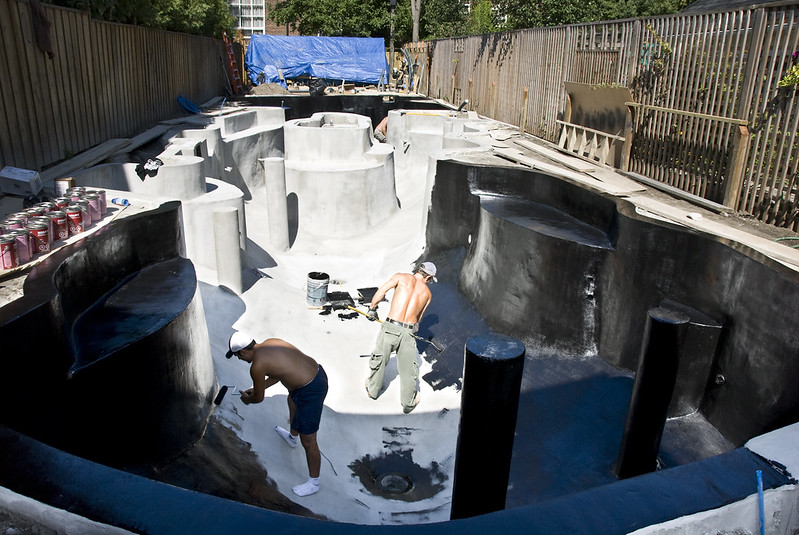
Another reason to seal a concrete pond is to save the reinforcement that is within the concrete. If the concrete is highly damp with water, the reinforcement will get corrosion soo. The result will be a large crack in the pond and water loss.
Although concrete can resist water to some degree, if there is a constant water load on concrete, the water can percolate through it. This causes water loss in the pond and also makes the outside of the pond damp. And if the pond is above the ground, there will surely be algae and moss growth which will make it unpleasing.
The final reason to paint a concrete pond is to give it a pleasing appearance. An unpainted concrete pond doesn’t look good as the color of the concrete is not black. Most of the pond owner wants their pond to be black because a pond with a black bottom looks the best.
Epoxy Paint or Rubber Sealant – Which One To Choose For Your Pond
If you have a smooth concrete pond and no problem with the budget, you should go for epoxy paint. Epoxy paint makes it easier to clean the pond and prevents algae growth on the side as it is very smooth. It also takes very little time to cure. Again there is no need to apply any primer if you use it.
Liquid rubber is recommended when you have a rough finish in your pond, like an unfinished brick pond. It also saves you some bucks when it comes to coverage per gallon. But it takes a longer time to cure than the epoxy. Again algae growth is more than the epoxy as the surface isn’t smooth.
Whatever paint of sealer you choose for your pond, make sure it is safe for fish and pond plants. Also, make sure it is durable because you don’t want to paint your pond every year.
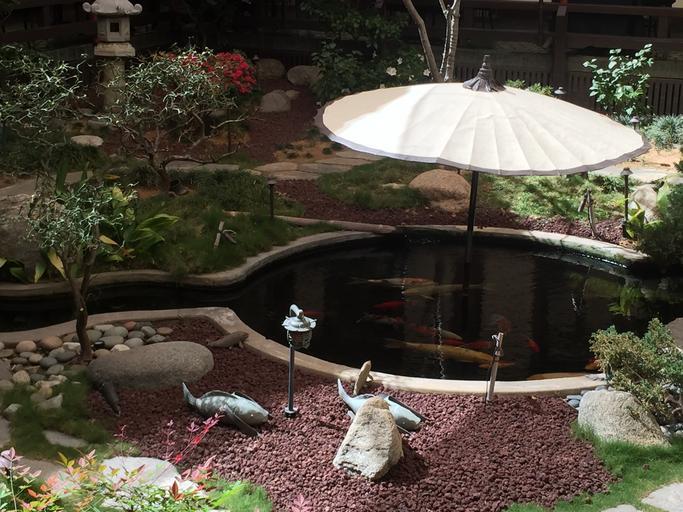





Hi. We have a concrete duck pond which has now developed cracks all over.
Please advise which is the best thing to use to fix this.
I am in South Africa and we have a very bad water shortage so really don’t want to waste water through the leaks.
Thank you so much.
Beverley
Hi There,
The sealing method depends on the type of crack. If cracks are micro hair crack, then you should use a rubber concrete sealer. Cracks larger than that should be treated with hydraulic cement patches.
Hi. We are constructing a rectangular water feature about 4′ x 6′, with masonry walls coming up out of the ground along the perimeter. We will use a plastic liner with pad, and the liner will come up and will need to be attached to the masonry walls of the surround. Can you recommend a method for this? Thanks.
Hey John,
Build the basic masonry structure first. When it sets lay the liner over it and attach carefully with sealant or any other appropriate method. Then cover the bottom with a mix of gravel or coarse sand. If you want to submerge pond plants water lilies, lotus, etc. then use a layer of soil beneath the gravel-sand layer. Use some rock to hide the liner that comes above the masonry wall and easily noticeable.
Hi I have built a small wild life pond we used a plastic pond liner and finished the top off by bringing the liner under and up behind a top capping of brick work left it to dry etc the problem is i have some leaking can i use either of these products to seal the area between the liner and bricks
Neither of these will solve your problem. I think you can use pond foam for this.
What type of primer do you recommend under the rubber sealant? I have leftover Drylok- is this appropriate? Thank you.
Hey steve. Thank you for your comment. You dont need a primer for rubber sealant.
How long should you let concrete cure before you apply the paint you recommended ? Also why does black colors prevail as opposed to say a green walls?
Concrete needs to be cured 28 days to have 90% of maximum strength. For curing it needs to be moist. So I will recommend you paint it after 28 days of placing the concrete.
Again black is most privileged because it gives a natural look and can absorb a wider range of wavelengths of the spectrum.
Hello, what about using this for an entire inground swimming pool with cement floor, but polymer walls. I’m tired of pool liner issues. And considering using this all over pool, yes will be expensive but better than replacing liner every few years. Any thoughts?
Thanks
Ms.Kentucky
Yes, you can do that. Just give special attention to the joints.
Hi
We have a pond that has a leak in the liner, we’ve tried a tape that can be submerged to stop leak. It worked for about 6 months, now its coming off and pond is leaking again. Is there any sort of paintable sealant/membrane or epoxy that we could paint over the liner to seal any leaks?
Cheers
Zach
It will be better to use a pond liner patching kit for this job. You can find it easily in your local store and online.
I am in the process of cleaning and fixing a large Koi Pond that came with the house we prchased 4-Years ago. Likely establish 10+ years ago. the concrete is crumbly around the wate line (it must have been sealed with something, but coming apart now). No leaking that I can detect. Fish are doing fine. Have not lost one in over two years. Two ponds actually; upper (about 3,500 gallons) that waterfalls into a lower (about 5,000 gallons). I plan to transfer all fish to one and work on the other, then reverse the process. My big question is why BLACK.??? I’d think a light or dark blue would “look” better. As this is rather new to me, I figured best to ask. Thank you
Mike
Basically black color has two advantages. Firstly it gives a natural look to the pond and secondly, black color can absorb a broad range of wave lenght of the spectrum.
I have a small concrete pond, rectangular in shape and in good condition. The previous owner painted it and now the paint has peeled off. I can scrape the old paint. Should I use a rubber sealer? Do I have to prep the surface first in any way? Does rubber sealer come in the colour blue? This pond will have no fish or plants.
Use the rubber sealer. And yes, rubber sealer is available in blue color.
I’m begging for some good information please?? Can you use this on a PVC liner? I have tried this 3 times and I just don’t think I have it in me to do again unless I can find a sure thing as far as keeping the water to leak out of the seams where 2 liners were put together? And body. It’s just not in my budget right now to buy 1 liner the exact size. However this wasn’t supposed to be this big when I started.
These sealers and paint won’t work for joining two pieces of liners. You will need quick prime or quick prime spray to join them.
Greetings,
I am building an aquaponics system. I will be using 6″ cement bricks for my fish tank (4x4x3). What can I use as a sealant that is fish safe and food safe.
Thanks,
Frank
I recommend you use the liquid rubber sealant for your pond.
I have a small approximately 175 gallon cement pond with a 37″ deep bottom and no drain. It was installed over 2018-19. I liner I installed last year worked until mid-this summer, then drained down to a place where the thick black liner has torn. I could use a liner kit to repair this tear, though I fear more tears will appear over time.
This points toward some sort of brushed or sprayed on pond non-toxic pond line. I understand there are two methods of drying out the concrete making the surface suitable so the concrete is dry through the thickness of the concrete, (3-4″ thick in this case).
These methods are: Desiccant DH and Condensation DH
What can you tell me about these methods of drying concrete and which one would you suggest?
I think desiccant DH will be better than Condensation DH as it removes the water from concrete.
I have 5 ponds divided up two sides of steps. The ponds have rubber and PKE liners. The falls are made of porous rock and they are leaking. I want to paint a sealant on my rocks where the waterfalls fall. Which is best:
1. flex seal
2. liquid rubber
3. pond shield
4. Herco
Hello
I have a painted concrete pond with hairline cracks. The paint is not flaking. Should i try to remove all of paint or is there a product that can go over it?
Thanks
What can I use to repaint a plastic preformed waterfall?